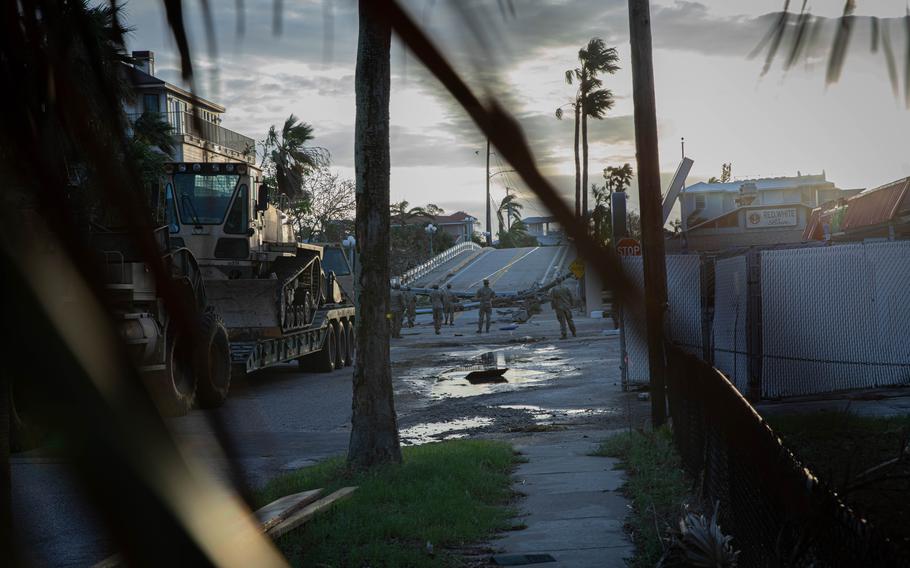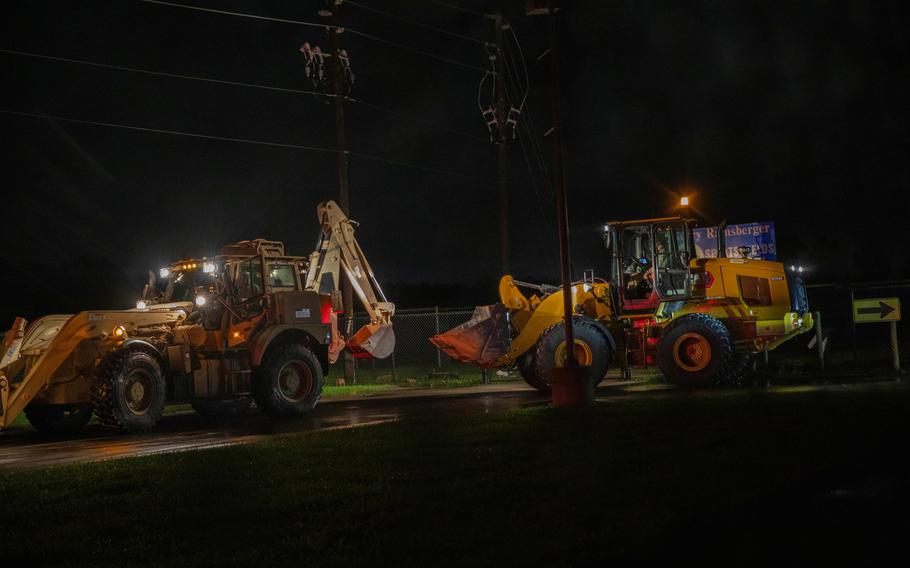
Florida National Guard soldiers from the 753rd Brigade Engineer Battalion, 53rd Infantry Brigade Combat Team, begin clearing debris and help to restore communities after Hurricane Milton in Pass-a-Grille, Fla., on Oct. 10, 2024. (Maddie Fortune/U.S. Army)
Some 6,500 Florida National Guard troops began recovery operations after Hurricane Milton tore across the state’s peninsula Wednesday evening into Thursday morning, military officials said.
The entire Florida National Guard was joined by Guard forces from at least seven other states as they began route clearance, search and rescue, and other missions before dawn Thursday after the fast-moving storm struck as a Category 3 hurricane in Siesta Key near Sarasota, officials said. Milton, once a Category 5 hurricane, was initially targeted to wallop Florida directly at the populous Tampa area, but it ultimately struck south of the city.
Milton was the second major hurricane to strike Florida in just two weeks, after Hurricane Helene on Sept. 26 hit the state northwest of the Tampa area as a Category 4 storm near the Big Bend region. While Helene continued northeast, devastating communities from Florida to North Carolina, Milton continued across the peninsula Thursday into the Atlantic Ocean, according to the National Hurricane Center.

Florida National Guard soldiers from the 753rd Brigade Engineer Battalion, 53rd Infantry Brigade Combat Team, load up and move out to begin clearing debris and restoring communities after Hurricane Milton in Gulfport, Fla., on Oct. 10, 2024. (Maddie Fortune/U.S. Army)
Guard photos posted early Thursday showed soldiers working before sunrise to clear debris from roads in coastal Gulfport and Pass-a-Grille, Fla., near Tampa.
The state’s Guard prepositioned troops throughout the state to quickly respond to the storm once it was safe, said William Manley, a Florida National Guard spokesman. That included placing liaison officers alongside local and state emergency response officials in 26 counties. Those officers had received at least 124 missions by noon local time on Thursday, Manley said.
Florida Guard forces had 31 helicopters, 13 boats and 440 high-wheeled tactical vehicles ready to deploy across the state, he said.
The Florida Guard was joined by Guard troops from other states including South Carolina, Virginia, Michigan, Mississippi, Arkansas, New York and Louisiana.
The New York Guard said it provided Florida with 41 soldiers, 24 airmen and 10 Army Humvees. The Air National Guard troops, according to a New York Guard statement, are pararescue forces trained to serve as emergency medical technicians.
The Mississippi Guard said it sent 22 soldiers, two HH-60 Black Hawk helicopters and a CH-47 Chinook heavy lift helicopter to Florida ahead of Milton.
Thousands more Guard forces from more than a dozen states remained on duty in other areas of the southeast for recovery operations in the wake of Hurricane Helene. At least 1,500 active-duty soldiers from Fort Liberty, N.C., and Fort Campbell, Ky., were also working in western North Carolina on Thursday to aid recovery in the mountainous communities there that faced the most devastation from that storm.
Air Force and Navy officials said Thursday that storm recovery officials were just beginning assessments of damage caused by Hurricane Milton.
A recovery team was en route to MacDill Air Force Base on Thursday morning, where officials said the installation would remain closed until further notice. Milton dropped nearly 10 inches of rain in areas near MacDill, according to the National Weather Service, but Tampa appeared to avoid the worst of the storm surge, which peaked at about 10 feet in Sarasota, about 70 miles south of the base.
Helene produced storm surge beyond 20 feet in Taylor County, where it made landfall, the weather service reported.
Storm damage assessments had begun at Patrick Space Force Base near Cape Canaveral, where officials encouraged residents to remain sheltered Thursday until it was completed.
Navy officials said several bases affected by the storm would remain closed at least until Friday after assessments were completed. Those included Naval Station Mayport and nearby Naval Air Station Jacksonville. Photos shared on social media showed downed trees on Naval Station Mayport. Naval Submarine Base Kings Bay, in coastal Georgia just north of the Florida border, reopened for normal operations Thursday, officials there said.
Early indications showed less damage from Milton than Florida officials had feared, especially after the state was already facing damage estimates from Helene as high as $50 billion, according to Gov. Ron DeSantis.
“What we can say is the storm was significant, but thankfully, this was not the worst-case scenario,” he told reporters Thursday morning. “The storm did weaken before landfall, and the storm surge, as initially reported, has not been as significant overall as what was observed for Hurricane Helene.”